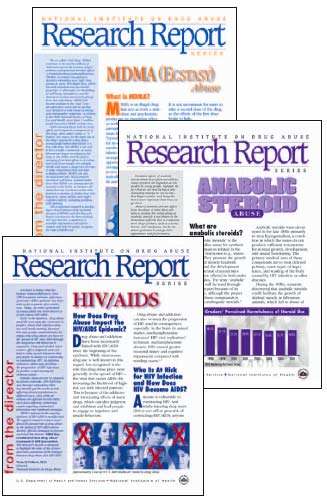NIDA has updated its Research Reports on MDMA/ecstasy and steroids and published a new report on HIV/AIDS. The Institute's Research Report series provides educators, parents, clinicians, and others the latest available information on drugs and drug-related topics.

HIV/AIDS
Approximately four of every 10 AIDS deaths in the United States are related to drug abuse. This somber message is depicted on the cover of the Report on HIV/AIDS. The Report's contents focus on the roles that intravenous drug use and drug-influenced high-risk sex play in spreading the epidemic.
Along with the latest data on AIDS cases and deaths, the Report describes changes in the epidemic over the past 25 years; the disparate impact of the disease on different subpopulations; effective approaches for prevention; and NIDA's ongoing support of research to develop strategies to prevent and treat the disease.
View Research Report - HIV/AIDS
MDMA/Ecstasy
This Report brings welcome news from recent surveys, which indicate that abuse of this club drug may be on the decline. The 2004 National Survey on Drug Use and Health estimates that the number of current adolescent and adult methylenedioxymethamphetamine (MDMA/ecstasy) abusers in the United States declined from 676,000 in 2002 to 450,000 in 2004. Similarly, the 2005 Monitoring the Future (MTF) survey found that past-year abuse fell 59 percent among middle and high school students between 2001 and 2005.
Nevertheless, more than 11 million reported trying the stimulant-hallucinogen at least once in their lives. The report describes the characteristics and history of ecstasy, the scope of its abuse in the United States, and its harmful effects.
View Research Report - MDMA (Ecstasy) Abuse
Steroids
This updated Report provides new data on anabolic androgenic steroid abuse among teenagers. Based on the 2005 MTF Survey, steroid abuse by teens in 8th and 10th grade has declined since 2000. The trend among 12th graders was different: abuse increased from 2000 to 2004, and then dropped in 2005 from 2.5 percent to 1.5 percent.
NIDA Director Dr. Nora D. Volkow points out that steroids differ from other drugs of abuse in that their appeal lies in their ability to change one's appearance and performance. As such, they may be a more insidious source of danger. "The effects of steroids can boost confidence and strength, leading the abuser to overlook the potential serious and long-term damage that these substances can cause," she notes.
The Report describes what steroids are, how they are abused, and the harmful side effects that can result. It also lists sources of additional information and resources.
